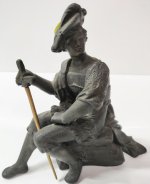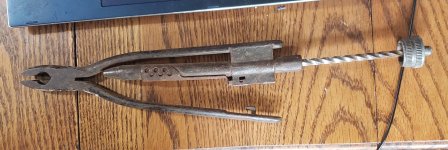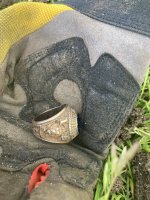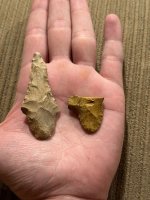kenb
Bronze Member
Mountain treasure: Museum chock-full of history and Old West artifacts
By BEVERLY CORBEL
The Daily Sentinel
Saturday, November 17, 2007
MONTROSE — Few people know their life’s passion at a young age, but museum owner Rich Fike collected his first artifact, an old clock, when he was just 4 years old.
At 8, he opened his first museum in his parents’ guest room, and at age 12, he starting keeping written records of his historic inventory.
With more than 500,000 artifacts in his Museum of the Mountain West, 67-year-old Fike still loves a good find.
“I just got a Civil War bullet probe,” he said, lovingly gazing at an old implement used to clean out gunshot wounds.
On five acres of land along U.S. Highway 50 about two miles east of Montrose, Fike’s museum includes about a dozen historic buildings he has bought or salvaged over the years. Some he has completely furnished as they would have been in the past. Some are works in progress.
Among the museum’s buildings are Montrose’s first railroad depot, a “section house” where railroad workers lived, an 1889 schoolhouse, log cabins, completely furnished blacksmith and gun shops, a livery stable full of old buggies and wagons and the German Lutheran Church from Montrose.
The basement of the old church will eventually become a library and research center for historians and scholars, he said.
Fike and his wife, Carol Harris-Fike, have worked for five years to develop the museum, which received nonprofit status in 2005.
The grass around the museum’s buildings may be overgrown, but landscaping will come later, Harris-Fike said.
Born in Grand Island, Neb., Fike grew up in Nebraska, Canada and Alaska. His father supported the family as the leader of Ronnie Fike and His Orchestra.
But instead of music, the younger Fike was drawn to history.
Fike, who was a state archaeologist for the U.S. Bureau of Land Management in Utah and Colorado for 24 years, is a historic preservationist.
He has restored many old mine buildings and historic structures such as the Sherbino Theater in Ridgway, now operating as the Sherbino Performing Arts Theater.
Fike restored the theater with funding from grants and a lot of community input and support, said Shannon McCarty, who runs the theater and bought the building from Fike in 2000.
Fike has taught courses in architectural history, published hundreds of papers and written several books including “The Bottle Book: A Comprehensive Guide to Historic Embossed Medicine Bottles.”
“He has hundreds of historic bottles,” Harris-Fike said. “Rich is an expert and can identify glass shards just from the color.”
Most of the museum’s artifacts are housed in a 10,000-square-foot metal building Fike built.
The present disappears into the past with one step inside the building. An entire enclosed town is revealed with street lamps, wooden sidewalks, storefronts and offices with signs out front and shingled roof overhangs. It’s kind of like a Hollywood movie set.
All the buildings are outfitted with furnishings and artifacts from their time periods.
Going into Schmidt’s Cash Store is like traveling back in time about 100 years, down to the most minute detail.
Many of the items in the store came from Fike’s family.
His grandfather, whose last name was Schmidt, had a grocery store in Nebraska.
He bought the 1880-era inventory from a dry goods store, and for some reason, stored much of its contents in his basement for decades.
That old merchandise is now in the museum’s tiny store and includes clothes, cash registers, corn planters and a mechanical vacuum cleaner built in 1913.
“It’s so heavy you can barely pick it up,” Fike said. “It works like a tire pump.”
Rug beaters, beaver and silk top hats, formal wear, high-button shoes, tiny metal toy cars and countless notions fill the little shop. There’s even a basket full of antique marbles, some made of clay and hand-painted. A stereoscope, sort of an early 3-D viewer invented in 1838, sits on the crowded counter.
Fike, a tall man with the demeanor of a graceful cowboy, speaks with authority while casually describing each item’s history and time period.
Down the indoor museum street, Fike walks into the fully furnished office of Dr. Abijah Johnson, Montrose’s first physician. He practiced from 1885 to 1910. The office contains the implements Johnson used in his practice, including his amputation saw.
“Later, Dr. Harriett Collins came in and brought the first X-ray machine to the area,” Fike said. “Doctors from all over the Western Slope would come here to use it.”
An old human skull sits on a desk in the doctor’s office. “He got it from a former Harvard medical student. Back then, medical students had to have a real skeleton,” Fike said.
Skeletons were ordered from India until someone realized how the orders were always filled exactly, Fike said.
“People were being killed for their skeletons,” he said. “Later, laws said they had to be out of plastic or other material.”
In the doctor’s sitting room with carpeting from 1860, an 1869 organ sits against one wall and an Edison cylinder phonograph stands in a corner. Both are in working condition.
“I got the horn out of a pigpen,” Fike said.
The Miner’s Saloon is a short walk away, but unlike Western movies, there are no swinging doors.
“Kids want to know where the swinging doors are, but they were rare, a Hollywood fabrication,” Fike said. “It does have bars on the windows, but they were put there to keep the drunks from falling back inside.”
Just inside the saloon’s entrance is 1908 pool table, an antique roulette table and an old poker table along with a Western Electric player piano and other entertainment machines from the 1800s, such as a mechanical horse-racing game.
One of the most intriguing old machines is the Violana Virtuoso, which Fike said was originally built in the early 1900s and was last played on an English cruise ship in 1940.
When a coin is inserted, a violin bow comes crisply down and plays a song on the strings of a violin while a piano-style stop mechanism in the back plays accompaniment.
“I first saw one as a kid, and said, ‘I have to have one,’ ” Fike said.
Many years later, he paid $4,000 for the machine, which he had to entirely rebuild.
That attention to detail no doubt helped Fike create the museum, which is also a result of the tenacity for collecting he exhibited as a boy, Harris-Fike said.
When he was young, Fike’s family lived for a time in Alaska, she said.
When the time came for them to move, Fike refused to get on the boat because he didn’t have the antique clock he got from his grandparents when he was 4, Harris-Fike said.
His parents finally had to relent because he wouldn’t back down.
“They went back and got it,” Harris-Fike said. “We still have it in our house.”
•
kenb
By BEVERLY CORBEL
The Daily Sentinel
Saturday, November 17, 2007
MONTROSE — Few people know their life’s passion at a young age, but museum owner Rich Fike collected his first artifact, an old clock, when he was just 4 years old.
At 8, he opened his first museum in his parents’ guest room, and at age 12, he starting keeping written records of his historic inventory.
With more than 500,000 artifacts in his Museum of the Mountain West, 67-year-old Fike still loves a good find.
“I just got a Civil War bullet probe,” he said, lovingly gazing at an old implement used to clean out gunshot wounds.
On five acres of land along U.S. Highway 50 about two miles east of Montrose, Fike’s museum includes about a dozen historic buildings he has bought or salvaged over the years. Some he has completely furnished as they would have been in the past. Some are works in progress.
Among the museum’s buildings are Montrose’s first railroad depot, a “section house” where railroad workers lived, an 1889 schoolhouse, log cabins, completely furnished blacksmith and gun shops, a livery stable full of old buggies and wagons and the German Lutheran Church from Montrose.
The basement of the old church will eventually become a library and research center for historians and scholars, he said.
Fike and his wife, Carol Harris-Fike, have worked for five years to develop the museum, which received nonprofit status in 2005.
The grass around the museum’s buildings may be overgrown, but landscaping will come later, Harris-Fike said.
Born in Grand Island, Neb., Fike grew up in Nebraska, Canada and Alaska. His father supported the family as the leader of Ronnie Fike and His Orchestra.
But instead of music, the younger Fike was drawn to history.
Fike, who was a state archaeologist for the U.S. Bureau of Land Management in Utah and Colorado for 24 years, is a historic preservationist.
He has restored many old mine buildings and historic structures such as the Sherbino Theater in Ridgway, now operating as the Sherbino Performing Arts Theater.
Fike restored the theater with funding from grants and a lot of community input and support, said Shannon McCarty, who runs the theater and bought the building from Fike in 2000.
Fike has taught courses in architectural history, published hundreds of papers and written several books including “The Bottle Book: A Comprehensive Guide to Historic Embossed Medicine Bottles.”
“He has hundreds of historic bottles,” Harris-Fike said. “Rich is an expert and can identify glass shards just from the color.”
Most of the museum’s artifacts are housed in a 10,000-square-foot metal building Fike built.
The present disappears into the past with one step inside the building. An entire enclosed town is revealed with street lamps, wooden sidewalks, storefronts and offices with signs out front and shingled roof overhangs. It’s kind of like a Hollywood movie set.
All the buildings are outfitted with furnishings and artifacts from their time periods.
Going into Schmidt’s Cash Store is like traveling back in time about 100 years, down to the most minute detail.
Many of the items in the store came from Fike’s family.
His grandfather, whose last name was Schmidt, had a grocery store in Nebraska.
He bought the 1880-era inventory from a dry goods store, and for some reason, stored much of its contents in his basement for decades.
That old merchandise is now in the museum’s tiny store and includes clothes, cash registers, corn planters and a mechanical vacuum cleaner built in 1913.
“It’s so heavy you can barely pick it up,” Fike said. “It works like a tire pump.”
Rug beaters, beaver and silk top hats, formal wear, high-button shoes, tiny metal toy cars and countless notions fill the little shop. There’s even a basket full of antique marbles, some made of clay and hand-painted. A stereoscope, sort of an early 3-D viewer invented in 1838, sits on the crowded counter.
Fike, a tall man with the demeanor of a graceful cowboy, speaks with authority while casually describing each item’s history and time period.
Down the indoor museum street, Fike walks into the fully furnished office of Dr. Abijah Johnson, Montrose’s first physician. He practiced from 1885 to 1910. The office contains the implements Johnson used in his practice, including his amputation saw.
“Later, Dr. Harriett Collins came in and brought the first X-ray machine to the area,” Fike said. “Doctors from all over the Western Slope would come here to use it.”
An old human skull sits on a desk in the doctor’s office. “He got it from a former Harvard medical student. Back then, medical students had to have a real skeleton,” Fike said.
Skeletons were ordered from India until someone realized how the orders were always filled exactly, Fike said.
“People were being killed for their skeletons,” he said. “Later, laws said they had to be out of plastic or other material.”
In the doctor’s sitting room with carpeting from 1860, an 1869 organ sits against one wall and an Edison cylinder phonograph stands in a corner. Both are in working condition.
“I got the horn out of a pigpen,” Fike said.
The Miner’s Saloon is a short walk away, but unlike Western movies, there are no swinging doors.
“Kids want to know where the swinging doors are, but they were rare, a Hollywood fabrication,” Fike said. “It does have bars on the windows, but they were put there to keep the drunks from falling back inside.”
Just inside the saloon’s entrance is 1908 pool table, an antique roulette table and an old poker table along with a Western Electric player piano and other entertainment machines from the 1800s, such as a mechanical horse-racing game.
One of the most intriguing old machines is the Violana Virtuoso, which Fike said was originally built in the early 1900s and was last played on an English cruise ship in 1940.
When a coin is inserted, a violin bow comes crisply down and plays a song on the strings of a violin while a piano-style stop mechanism in the back plays accompaniment.
“I first saw one as a kid, and said, ‘I have to have one,’ ” Fike said.
Many years later, he paid $4,000 for the machine, which he had to entirely rebuild.
That attention to detail no doubt helped Fike create the museum, which is also a result of the tenacity for collecting he exhibited as a boy, Harris-Fike said.
When he was young, Fike’s family lived for a time in Alaska, she said.
When the time came for them to move, Fike refused to get on the boat because he didn’t have the antique clock he got from his grandparents when he was 4, Harris-Fike said.
His parents finally had to relent because he wouldn’t back down.
“They went back and got it,” Harris-Fike said. “We still have it in our house.”
•
kenb







